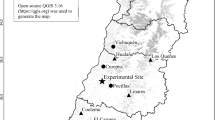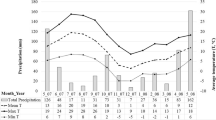Abstract
In Mediterranean climates, seedlings are frequently shaded in the nursery to avoid heat damage and save water. However, the impact of this shading on the seedling quality and transplanting performance of Mediterranean species is not well known. We studied the effect of nursery shading on pre-planting features and post-planting performance of two Mediterranean tree species: the shade-intolerant pioneer Pinus halepensis and the shade-tolerant late-successional Quercus ilex. We grew one-year-old seedlings of both species under 100, 40 and 5% full sunlight. Shade had a low impact on the morphology and physiology of Q. ilex seedlings. In pines, only the deep shade treatment produced low quality seedlings with poor root development. In both species, transference to high light at planting in autumn did not impose any additional stress than that caused by frosts, but initial root growth was impaired in the two shaded treatments in pine. Post-planting growth and survival of oak seedlings showed no difference between treatments. Pine seedlings grown in deep shade showed higher mortality and lower growth after planting than those grown in full sun and intermediate light treatments, while intermediate light only reduced growth. For the nursery culture of Q. ilex seedlings, we advise using low light levels during summer to save water without impairing field performance. In P. halepensis, seedlings should be cultured under full sunlight conditions to maximize post-planting growth, but they can be cultured under intermediate light without impairing survival.





Similar content being viewed by others
References
Aranda I, Pardos M, Puértolas J, Jiménez MD, Pardos JA (2007) Water use efficiency in cork oak (Quercus suber) is modified by the interaction of water and light availabilities. Tree Physiol 27:671–677
Awada T, Radoglou K, Fotelli MN, Constantinidou HIA (2003) Ecophysiology of seedlings of three Mediterranean pine species in contrasting light regimes. Tree Physiol 23:33–41
Barnes JDB, Balaguer L, Manrique E, Elvira S, Davison AW (1992) A reapraisal of the use of DMSO for the extaction and determination of chlorophylls a and b in the lichens and higher plants. Environ Exp Bot 32:85–100. doi:10.1016/0098-8472(92)90034-Y
Bazzaz FA, Carlson RW (1982) Photosynthetic acclimation to variability in the light environment of early and late successional plants. Oecologia 54:313–316. doi:10.1007/BF00379999
Björkman O, Boardman NK, Anderson JM, Thorne SW, Goodchild DJ, Pyliotis NA (1972) Effect of light intensity during growth of Atriplex patula on the capacity of photosynthetic reactions, chloroplast components and structure. Carnegie Inst Washington Year Book 71:115–135
Castro-Díez P, Navarro J, Pintado A, Sancho LG, Maestro M (2006) Interactive effects of shade and irrigation on the performance of seedlings of three Mediterranean Quercus species. Tree Physiol 26:389–400. doi:10.1093/treephys/26.3.389
Chapin FS III, Schulze E-D, Mooney HA (1990) The ecology and economics of storage in plants. Annu Rev Ecol Syst 21:423–447. doi:10.1146/annurev.es.21.110190.002231
Close DC, Beadle CL, Holz GK, Brown PH (2002) Effect of shadecloth tree shelters on cold-induced photoinhibition, foliar anthocyanin and growth of Eucalyptus globulus and E. nitens seedlings during establishment. Aust J Bot 50:15–20. doi:10.1071/BT01038
Cochard H, Lemoine D, Dreyer E (1999) The effects of acclimation to sunlight on the xylem vulnerability to embolism in Fagus sylvatica L. Plant Cell Environ 22:101–108. doi:10.1046/j.1365-3040.1999.00367.x
Evans CA, Miller EK, Friedland AJ (2001) Effect of nitrogen and light on nutrient concentrations and associated physiological responses in birch and fir seedlings. Plant Soil 236:197–207. doi:10.1023/A:1012772604362
Fernández M, Tapias R (2005) Influencia de la intensidad luminosa sobre la tasa fotosintética de los pinos españoles. Cuad Soc Esp Cien For 20:73–78
Gamper R, Mayr S, Bauer H (2000) Similar susceptibility to excess irradiance in sun and shade acclimated saplings of Norway spruce (Picea abies [L.] Karst.) and stone pine (Pinus cembra L.). Photosynthetica 38:373–378. doi:10.1023/A:1010965319054
García-Plazaola JL, Artetxe U, Becerril JM (1999) Diurnal changes in antioxidant and carotenoid composition in the Mediterranean sclerophyll tree Quercus ilex (L.) during winter. Plant Sci 143:125–133. doi:10.1016/S0168-9452(99)00034-5
Grossnickle S (2005) Importance of root growth in overcoming planting stress. New For 30:273–294. doi:10.1007/s11056-004-8303-2
Hastwell GT, Facelli JM (2003) Differing effects of shade-induced facilitation on growth and survival during the establishment of a chenopod shrub. J Ecol 91:941–950. doi:10.1046/j.1365-2745.2003.00832.x
Johnson JD, Tognetti R, Michelozzi M, Pinzauti S, Minotta G, Borghetti M (1997) Ecophysiological responses of Fagus sylvatica seedlings to changing light conditions. II. The interaction of light environment and soil fertility on seedling physiology. Physiol Plant 101:124–134. doi:10.1111/j.1399-3054.1997.tb01828.x
Leiva MJ, Fernández-Alés R (1998) Variability in seedling water status during drought within a Quercus ilex subsp. ballota population, and its relation to seedling morphology. For Ecol Manage 111:147–156
López B, Sabaté S, Gracia CA (2001) Annual and seasonal changes in fine root biomass of a Quercus ilex L. forest. Plant Soil 230:125–134. doi:10.1023/A:1004824719377
Luis VC, Puértolas J, Climent J, Peters J, González-Rodríguez MA, Morales D, Jiménez MS (2009) Nursery fertilization enhances survival and physiological status in Pinus canariensis seedlings planted in a semiarid environment. Eur J For Res 128:221–229. doi:10.1007/s10342-009-0257-7
Marshall JD (1986) Drought and shade interact to cause fine-root mortality in Douglas-fir seedlings. Plant Soil 91:51–60. doi:10.1007/BF02181818
Niinemets Ü (2003) Role of foliar nitrogen in light harvesting and shade tolerance of four temperate deciduous woody species. Funct Ecol 11:518–531. doi:10.1046/j.1365-2435.1997.00109.x
Niinemets Ü, Kull O, Tenhunen JD (1998) An analysis of light effects on foliar morphology, physiology, and light interception in temperate deciduous woody species of contrasting shade tolerance. Tree Physiol 18:681–696
Ogaya R, Peñuelas J (2003) Comparative seasonal gas exchange and chlorophyll fluorescence of two dominant woody species in a holm oak forest. Flora 198:132–141
Omi SK, Rose R, Sabin TE (1994) Fall lifting and long term freezing storage of ponderosa pine seedlings: effects on starch, root growth, and field performance. Can J Res 24:624–637. doi:10.1139/x94-082
Örlander G (1993) Shading reduces both visible and invisible frost damage to Norway spruce seedlings in the field. Forestry 66:27–36. doi:10.1093/forestry/66.1.27
Osmond CB (1994) What is photoinhibition? Some insights from comparisons of shade and sun plants. In: Baker NR, Bowyer JR (eds) Photoinhibition of photosynthesis: from molecular mechanisms to the field. BIOS Scientific Publishers Limited, Oxford, pp 1–24
Padilla FM, Pugnaire FI (2007) Rooting depth and soil moisture control Mediterranean woody seedling survival during drought. Funct Ecol 21:489–495. doi:10.1111/j.1365-2435.2007.01267.x
Pardos M, Jiménez MD, Aranda I, Puértolas J, Pardos JA (2005) Water relations of cork oak (Quercus suber L.) seedlings in response to shading and moderate stress. Ann Sci 62:377–384
Portsmouth A, Niinemets Ü (2007) Structural and physiological plasticity in response to light and nutrients in five temperate deciduous woody species of contrasting shade tolerante. Funct Ecol 21:61–77
Puértolas J, Pardos M, Jiménez MD, Aranda I, Pardos JA (2008) Interactive responses of Quercus suber seedlings to light and mild water stress: effects on morphology and gas exchange traits. Ann Sci 65:611
Rhizopoulou S, Meletiou-Christou MS, Diamantoglou S (1991) Water relations for sun and shade leaves of four Mediterranean evergreen sclerophylls. J Exp Bot 42:627–635. doi:10.1093/jxb/42.5.627
Rice KJ, Gordon DR, Hardison JL, Welker JM (1993) Phenotypic variation of a “keystone” tree species (Quercus douglasii): the interactive effects of acorn source and competitive environment. Oecologia 96:537–547. doi:10.1007/BF00320511
Rousset O, Lepart J (1999) Shrub facilitation of Quercus humilis regeneration in succession on calcareous grasslands. J Veg Sci 10:493–502. doi:10.2307/3237184
Sánchez-Gómez D, Valladares F, Zavala MA (2006) Performance of seedlings of Mediterranean woody species under experimental gradients of irradiance and water availability: trade-offs and evidence for niche differentiation. New Phytol 170:795–806. doi:10.1111/j.1469-8137.2006.01711.x
Sánchez-Gómez D, Zavala MA, Valladares F (2008) Functional traits and plasticity linked to seedlings’ performance under shade and drought in Mediterranean woody species. Ann Sci 65:311
Smith T, Huston M (1989) A theory of the spatial and temporal dynamics of plant communities. Plant Ecol 83:49–69. doi:10.1007/BF00031680
Tognetti R, Johnson JD, Michelozzi M (1997) Ecophysiological responses of Fagus sylvatica seedlings to changing light conditions. I. Interactions between photosynthetic acclimation and photoinhibition during simulated canopy gap formation. Physiol Plant 101:115–123. doi:10.1111/j.1399-3054.1997.tb01827.x
Valladares F, Martínez-Ferri L, Balaguer L, Pérez-Corona E, Manrique E (2000) Low leaf-level response to light and nutrients in Mediterranean evergreen oaks: a conservative resource-use strategy? New Phytol 148:79–91. doi:10.1046/j.1469-8137.2000.00737.x
Varone L, Gratani L (2007) Physiological response of eight Mediterranean maquis species to low air temperatures during winter. Photosynthetica 45:385–391. doi:10.1007/s11099-007-0065-6
Villar-Salvador P, Planelles R, Enríquez E, Peñuelas Rubira J (2004) Nursery cultivation regimes, plant functional attributes, and field performance relationships in the Mediterranean oak Quercus ilex L. For Ecol Manage 196:257–266
Wang Y, Zwiazek JJ (1999) Effects of early spring photosynthesis on carbohydrate content, bud flushing and root and shoot growth of Picea glauca bareroot seedlings. Scand J For Res 14:295–302. doi:10.1080/02827589950152601
Zazo J, Pinazo O, Planelles R, Vivar A, Cornejo L, López M (2001) Estudio de la influencia de la fertilización nitrogenada e iluminación sobre atributos morfológicos y fisiológicos de brinzales de Q. ilex L. cultivado en vivero. Resultados tras el primer año de campo. In: de Andalucía SECF-Junta (ed) III Congreso Forestal Español. Montes para la sociedad del nuevo milenio II. Gráficas Coria, Sevilla, pp 777–783
Zhang S, Hennessey TC, Heinemann RA (1997) Acclimation of loblolly pine (Pinus taeda) foliage to light intensity as related to leaf nitrogen availability. Can J Res 27:1032–1040. doi:10.1139/cjfr-27-7-1032
Acknowledgments
J. Puértolas is supported by funds of Consolider-Ingenio Program 2010 (GRACCIE project, CSD2007-00067), Spanish Ministry of Environment (ESTRES project, 063/SGTB/2007/7.1) and European Social Fund (Torres-Quevedo Program, PTQ05-02-03188). Generalitat Valenciana and Bancaja fund CEAM. We thank J. A. Pardos and L. Gil from the U. D. Anatomia, Fisiología y Genética (ETSI Montes, Madrid) for the infrastructure for chlorophyll determinations. Two anonymous referees helped to improve the manuscript with their suggestions.
Author information
Authors and Affiliations
Corresponding author
Rights and permissions
About this article
Cite this article
Puértolas, J., Benito, L.F. & Peñuelas, J.L. Effects of nursery shading on seedling quality and post-planting performance in two Mediterranean species with contrasting shade tolerance. New Forests 38, 295–308 (2009). https://doi.org/10.1007/s11056-009-9148-5
Received:
Accepted:
Published:
Issue Date:
DOI: https://doi.org/10.1007/s11056-009-9148-5




